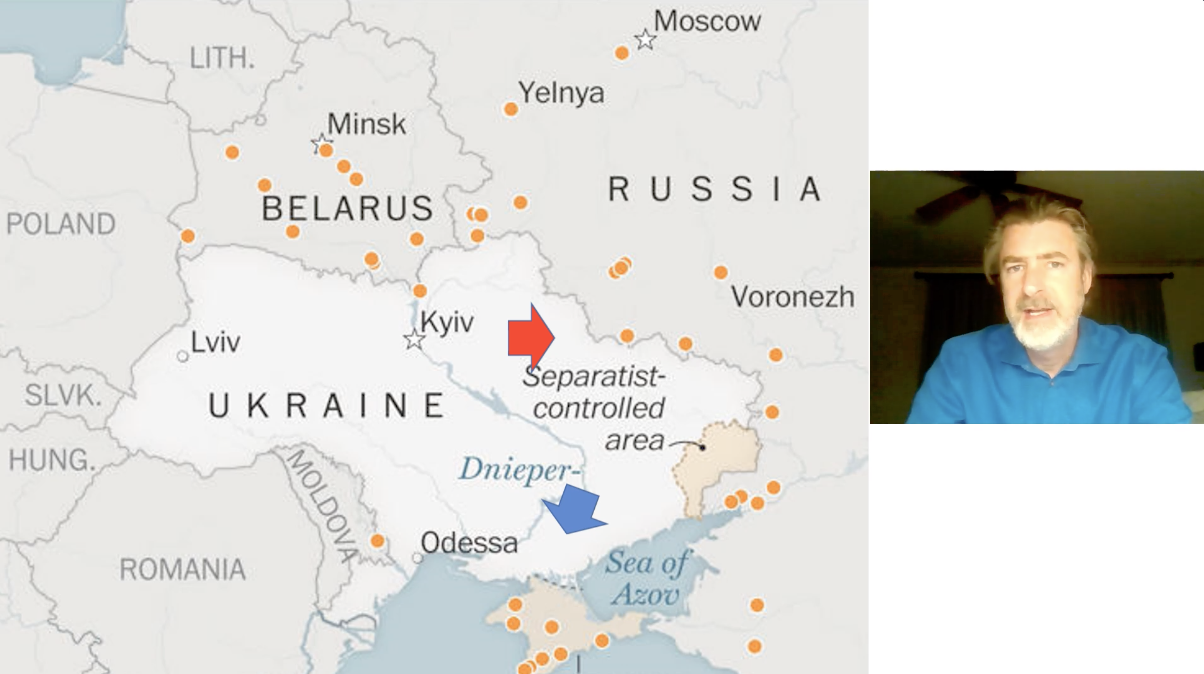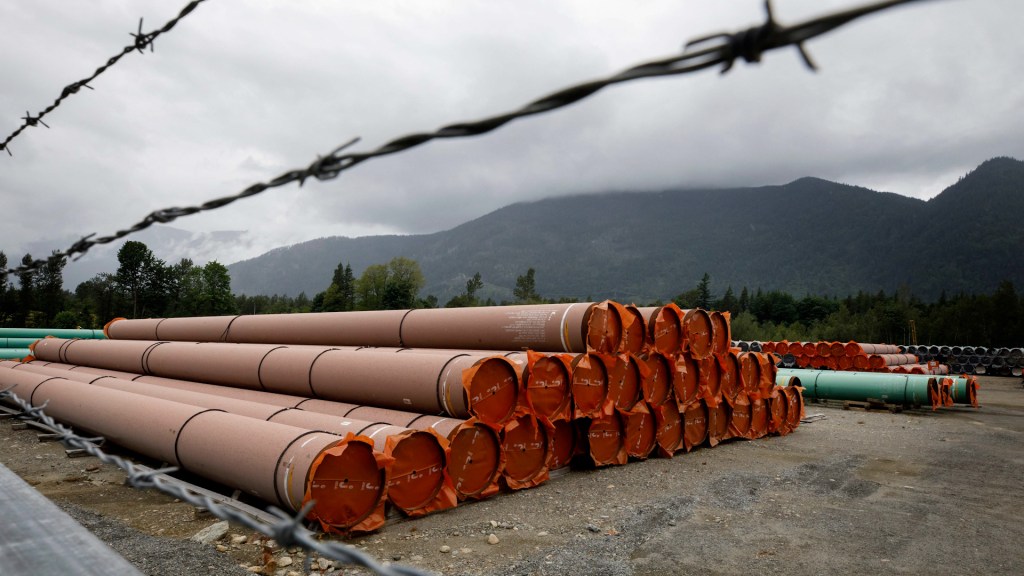
Commentary
-
Our commentary partners will help you reach your own conclusions on complex topics.
Hello, everyone. Peter Zeihan coming to you from Arizona, where I’m on a work trip. Uh, this video is brought to you by the Russian invasion of Ukraine. And of course coffee, because it’s just about 6:00 AM. Local time
Overnight, the Russians started putting troops into Ukraine. Sorry. Incorrect, local time in the morning, they put troops into Ukraine. So the first little lesson here is the Russians didn’t do any of this at night. Russian forces are not equipped for night fighting. Just something that to file away in the back of your mind for later. But more importantly, we know there are at least six major avenues of attack and that airstrikes have been carried out throughout the entirety of the country of Ukraine. In terms of physical size, Ukraine is roughly twice the size of Texas. So this is a large-scale operation. Putin has given a speech indicating that this is going to be dominating everything for the next weeks and months, made it very clear that his goal was to overthrow the government and install a puppet regime.
I mean, very clear from the speech, and he’s not going to stop until the entirety of the territory of Ukraine is considered friendly as termed by the way Moscow defines it. So we’re looking here at a wholesale capture and probably followed by an occupation of the country. One of the big outcomes of Russian previous invasions of Ukraine from roughly eight years ago was that the Russians have managed to convince everyone by their actions in Ukraine that Russia’s no longer a friendly state. So if this had happened a decade ago you could probably count on a third of the population of Ukraine being cooperative, but that time has passed, and it’s probably less than 5% of the population can be counted on to become Quislings. Everyone else is gonna resist. So let’s take a look at specifically, what is going on.
Here is a map of the current airstrikes as have been reported at 5:00 AM mountain time at 7:00 AM Eastern time. As you can see, they’re pretty much everywhere. Now that dotted shaded area in the far, far southeast, those are the two secessionist republics that Putin recognized a couple of days ago and started moving troops into yesterday. The, hashtag, the hash area to the north and to the west of that are the remainder of the provinces that these secessionist areas claim. Now, originally I was thinking that the first step, that the Russians were going to do was going to go to expand into that area, testing the west’s resolve. He has not done that. We’ve got troops moving in a number of areas. He’s actually going to swallow the entire country as quickly as possible.
There are three main attack avenues. The first one starts up here in Belarus and is going south to the capital Kyiv. It’s only about a hundred miles. The Russians have been stationing troops in billers as part of exercises for some time now. There’s probably about 30- or 40,000 troops there, as far as we can tell they are all on the move, going straight for the capital. And again, the Putin government has made it very clear their goal is to depose the government and install a Quisling regime.
The second big push starts here in the Crimea. Now the Russian’s last invasion of Ukraine back in 2007 succeeded in capturing the Ukraine in its entirety. And the forces that are moving out of Ukraine are coming north into the country to take over the water transport works and then moving west to get to the capital, commercial capital of Odessa. Odessa is at the mouth of the Dnieper river.
And it kind of serves as a Houston combined with a New Orleans and a St. Louis. It’s kind of the agricultural and industrial Heartland, and it taps all of the populations moving up the Dnieper River all the way to Kyiv and even back in Soviet times, into Belarus. If Odessa falls, that is the only port of significance in the entire Ukrainian country. And any support in any trade, that comes to or from the country will then have to go buy land, which is more expensive. And Soviet area infrastructure is still a little rickety. But the single most important thing that the Russians are after with Odessa is it gives the Russians complete control over the economic artery that allows Ukraine to even be functional to the degree. That is, this is not a very rich place. The only thing that might slow them down the Russians is the bridges over the Dnieper River.
Now, for those of you in the Midwest, you understand the importance of bridges. Getting across the Missouri, the Ohio, the Mississippi, it’s kind of a big deal. And if that bridge wasn’t there, you’d face some big problems. The Dnieper is roughly analogous to the greater Mississippi in the United States, long river, wide river, fairly fast flowing river. And if something were to happen to the bridges that would greatly complicate the Russians’ plans. So something to look for in the days ahead is whether or not the Ukrainians decide to blow them up themselves.
Third big push starts in those secessionist areas and will be heading west to the Crimea in order to link up the forces. And once that’s done, the Russians will kind of control a U of territory in the north and the east and the south, and then they can close in and finish off everything else.
Now that’s easier said than done. This is a country of 45 million people, and these first three big thrusts, this is the easy part. After that, the Russians are gonna be going town by town, village by village, farm by farm, having to pacify it. Their goal is to find enough Ukrainians to do this for them. I find that unlikely. Ten years ago, maybe, but the degree to which the Ukrainians are gonna turn on their own countrymen, I think is very light. I think the best example that you can think of is the American invasion of Iraq of 20 years ago. We went in and there was a significant percentage of the population, the Kurds, the Shia, for example, vast majority of the population who didn’t like Saddam Hussein. And so there was a moment in the first year where the United States actually had a pretty easy time of it because we had something like 70% of the population being neutral towards the United States.
That’s not gonna happen here. The population is bigger. The territory is bigger. The population is more hostile. And perhaps most importantly, we have a country where you can actually be in the countryside. Ukraine, unlike Iraq, is an agricultural zone. Whereas Iraq is about two thirds desert. It’s different hunting people in the desert when you can just use a little night vision, as opposed to doing it, when you think they just disappear into the farm fields, uh, this is gonna be a tough road to hoe.
Finally, a couple ancillary things. The Europeans are already meeting to decide what they can do about this. The Russians export a huge amount of oil and natural gas to the European unions by far their primary source of energy. And it’s by for Russia’s primary source of income, there are no clean substitutions, but it’s gonna be interesting to see what the Europeans attempt to do to square this circle.
Maybe they can turn on some nuclear power reactors. Maybe they can dig up some more local coal. It’s not that there aren’t any options. It’s just that they’re politically awkward at best. And Any help from beyond the European Union is gonna be very limited. The Europeans need to replace at least 10 billion cubic feet of natural gas a day. Technically the United States could supply a lot of that in liquified form, but every molecule of natural gas we send is a molecule of natural gas that disappears from the rest of the market. And it’s already claimed. So there really isn’t a lot of hope here. But the Europeans are the ones in the hot seat. They’re the ones who have to come up with a solution, if there is one. And if it turns out there’s not, then we got to think about the next step, which is what the Europeans do on the battlefield.
Now, the United States has made most of the major decisions and done most of the heavy lifting in European security since World War II by design, that was our choice. We didn’t want the Europeans to be militarily independent because that led to World War I and World War II. Now, it means that the European countries, for the most part, can’t dream of a conventional intervention, but they can supply equipment to the Ukrainians. France at this point has taken the strongest stance with President Emmanuel Macron just this morning, saying that every weapon they have that is conventional is available to the Ukrainians if they want it. Now, for those of you who have been following French politics and Macron’s to be perfectly blunt, grandstanding, and diplomacy, this might seem a little odd, but remember, the reason that France always comes across as a loose cannon and a free player is because it is a free player.
It’s opposite the European continent from where Russia is. So anything that happens on that Eastern periphery, they see as an opportunity rather than a threat. Couple weeks ago, the opportunity was for France to be seen as the king maker. Today, it’s France to be seen as the freedom fighter, good position to be in, if you can have it.
Third and most importantly, going back to the beginning, this was all during done during the day, which means that for countries like the United States who are loaded with equipment that allows for night fighting, the decisions that are made in Washington in the next 24 to 72 hours, about what we’re going to send is going to determine just how bloody the Russian occupation is going to be. There is an argument to be made that I find myself bit by bit coming around to that if the Russians are locked down in a long-scale, bloody occupation in Ukraine, that’s the end of their conventional capability. There’s something to be said from that point of view, the Ukrainians obviously don’t think of it as their first choice, but that was before the tanks actually started rolling. And for the Ukrainians now, resisting to the end might be the only game in town. Okay. folks, that’s it for me. Stays safe. Keep an eye on your relatives in Europe. And I will talk to you again soon.
-
How could RFK Jr. impact 2024 election?
Many Americans speculated about how a potential RFK, Jr. campaign might impact the 2024 elections. While RFK is neither a Democrat nor a Republican, many of his positions favor Donald Trump’s base over Joe Biden’s, particularly his various conspiracy theories on a wide range of subjects. Straight Arrow News contributor Peter Zeihan says that GOP…
-
Global warming won’t impact Russian-Chinese shipping
The seas above Russia’s northern coastline are too frozen for shipping, but some have wondered whether global warming might change that in the decades to come. If those seas were to become navigable for commercial shipping, new direct routes between Russia and China could theoretically open up. Straight Arrow News contributor Peter Zeihan throws more…
-
Can other nations replicate success of US shale revolution?
The “shale revolution” has provided the United States with a bountiful domestic supply of oil. But extracting oil from shale is a highly technical process, and it is also dependent on specific geological formations. Straight Arrow News contributor Peter Zeihan tackles the question of whether or not other nations might be able to replicate the…
-
Peace between Israel and Iran, at least for now
A series of recent airstrikes between Israel and Iran inflamed fears of a wider regional war erupting in the Middle East. That concern now seems to have paid off, after third-party countries around the world successfully intervened and talked down military hardliners in both Israel and Iran in order to avoid such an outcome. Israel’s…
-
Global internet in a precarious state, but that could be a positive
Over 500 underwater cables span over 870,000 miles worldwide, serving as the foundation of the modern global internet. Despite their critical role in facilitating communication, these cables often go unnoticed, even as the amount of data transmitted through them has surged. So what happens if the cables fail? Straight Arrow News contributor Peter Zeihan contends…
Latest Stories
-
 Reuters
Reuters
Musk visits Beijing as Tesla’s China-made cars clear data security hurdles
-

Trump holds private meeting with former GOP rival DeSantis
-
 Reuters
Reuters
Several dead after tornadoes sweep through Midwest
-
 Getty Images
Getty Images
Biden uses NFL draft ad to try to connect with young voters
-
 Getty Images
Getty Images
Powering pot: Energy for US cannabis industry could electrify 13.5M homes
Popular Opinions
-
In addition to the facts, we believe it’s vital to hear perspectives from all sides of the political spectrum.
Latest Opinions
In addition to the facts, we believe it’s vital to hear perspectives from all sides of the political spectrum. We hope these different voices will help you reach your own conclusions.
The opinions published in this section are solely those of the contributors and do not reflect the views of Straight Arrow News.

















Latest Commentary
We know it is important to hear from a diverse range of observers on the complex topics we face and believe our commentary partners will help you reach your own conclusions.
The commentaries published in this section are solely those of the contributors and do not reflect the views of Straight Arrow News.
Peter Zeihan
Geopolitical StrategistGlobal warming won’t impact Russian-Chinese shipping
Can other nations replicate success of US shale revolution?
Peace between Israel and Iran, at least for now
Dr. Frank Luntz
Pollster and Political Analyst‘Take the job seriously’: Why Americans are fed up with Congress
‘If we can shrink it, it will stop growing’: Americans talk debt, deficit
‘I don’t think they care’: Undecided voters explain their reasons
Pete Ricketts
U.S. Senator for Nebraska